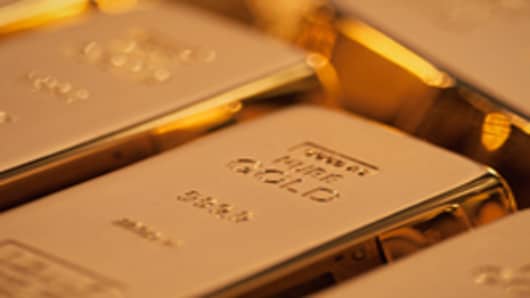Gold prices have been hitting record highs almost every day in recent weeks. For investors trying to figure out what to do, the situation gets more confusing when expert opinions on the outook for the yellow metal are as diverse as they are contradictory: Goldman Sachs says prices will hit $1650/oz within 12 months, but French bank Natixis says prices will actually decline in 2011 as the global economy recovers.
While Uwe Parpart, Chief Economist and Strategist for Asia at Cantor Fitzgerald, says all investors should own some gold in their portfolio, it’s easier said than done, as predicting the price of gold is just as tough as timing the stock market.
There are many ways to buy gold. You could buy an exchange-traded fund (ETF) such as the SPDRs GLD, mining stocks, futures contracts on the precious metals or the physical bullion itself. Each of these has its pros and cons.
Buying gold and storing it in a vault costs money and isn’t always practical for retail investors. Instead, John Stephenson, who’s written The Little Book of Commodity Investing, recommends investors buy shares in mining companies.
In his book, Stephenson argues that commodity ETFs, while popular, often suffer from “tracking error”. That means the ETF doesn’t always keep up with the rise in the price of the underlying commodity. For example the price of spot gold is up 26 percent this year (as of October 14th), while the Gold ETF GLD is up only 22 percent.
Buying mining shares though can mean buying execution or business risk. For example, Australia-listed miner Kingsgate recently warned that production in September was lower than expected because of maintenance at their flagship Chatree mine in Thailand as well as heavy rain.
You could also to use options to bet on gold prices. Chen Wai-Yee, the head of the derivatives desk at RBS Morgans in Sydney and the author of the book Optionswise: How to Invest Sensibly, says this is the best way to protect your gold investments.
For example you could buy a Call Option on Newcrest. The shares are currently trading around A$42.50 ($41.92). By buying a December Call Option with the strike price of $44, you have the opportunity to buy the shares on December 23rd for $44 a share.
Let’s say, the option costs just A$0.70. If by December, gold prices have risen even further, it’s possible Newcrest shares could hit A$50. In that case you stand to make A$50 minus the agreed upon price of A$44 and the cost of the option of A$0.70. That’s a total of A$5.30. Since you buy options in sizes of 1000 units, your total profit would be A$5300.
But what if gold prices drop causing Newcrest’s stock to tumble? To protect against this you can buy a December Put Option with the same strike price of A$44. In this case if gold prices tumble and Newcrest shares fall to say A$40 (a decline of 8.5 percent), you have the right on December 23rd to sell shares of Newcrest for A$44.
How do you sell shares you don’t own? Easy, you can buy the shares for A$38 in the market and sell them at A$44. Let’s say the option costs you A$1.50, you end up with a profit of $4.50 (A$44 minus the purchase price of A$38 and the cost of the option of A$1.50). Once again since you buy options in lot sizes of 1000, your profit would be A$4500.
By buying both Call and Put Options – you’ve constructed what’s called a Straddle – with one leg getting a boost from a rally and another leg of the trade ready to profit from a decline.
Such a strategy allows you to make money whether prices go up or go down. What’s the catch you ask? Well, if prices go nowhere, that’s where it’ll hurt, as you have plunked down A$700 (A$0.7 x 1000) for the Call Option and A$1500 (A$1.5 x 1000) for the Put Option. So now your pocket is lighter by A$2200.


